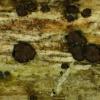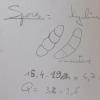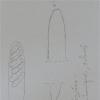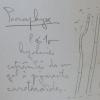
08-01-2026 21:22
 Blasco Rafael
Blasco Rafael
Hola, He recogido esta muestra de Orbilia sobre Re

07-01-2026 10:24
 Danny Newman
Danny Newman
Pezicula sp. on indet. hardwood Appalachian Highl

07-01-2026 22:22
 Danny Newman
Danny Newman
Tatraea sp. on indet. hardwood The Swag, Great Sm

07-01-2026 17:29
 Marc Detollenaere
Marc Detollenaere
Dear Forum,On a barkless Populus I found some smal

10-11-2021 17:33
 Riet van Oosten
Riet van Oosten
Add-on topic http://www.ascofrance.com/forum/7059

07-01-2026 10:05
 Danny Newman
Danny Newman
cf. Chaetospermum on XylariaCosby Campground, Grea

02-01-2026 17:43
MARICEL PATINOHi there, although I couldn't see the fruitbody, I

04-01-2026 17:45
 Stephen Martin Mifsud
Stephen Martin Mifsud
I was happy to find these orange asmocyetes which
 Hi.
Hi.Macro : apo with a red to dark red hymenium, excipulum dark. Same appearance than Rhytidisteron hysterinum when dry.
Found on dead branches of Cytisus oromediterraneus.
Micro : spores hyalines, 4-celled, 15,4-19x4,7-5,6 um Q=3,2-3,6
Ascus with bisseriate spores, IKI-, croziers+, 103-123x10,6-10,8 um
Paraphyses filiform, hyaline, without pigmentation, apex sometimes stuck in a red carotenoid gel. lI haven't be able to make a cross section because apo are too gelatinous.
See attached pictures.
So, I think this is clearly a Durella specie.
On Zotto's CD, I found a decription of Durella "aurantionigra" that fits very well with my specie. Is-it still a workname or has-it been described ?
What do you think about all of that ?
Yannick
?

You did no figure the spore contents, though I fear they are not constant in this group. But they are always there, lipid content around 4.
The anamorph could help in solving the problem if there are several species or not. The genus Plasia was found by Sherwood as anamorph, and I have data on associated sporodochia with different ?conidia, in the case you find something similar to the apothecia but with conidia inside.
Zotto

No, I haven't seen any oil drop inside these spores. I have checked it now.
Sorry, I don't understand your first sentence : "I am not sure if there is only one variable species D. atrocyaneam?". What do you meen ? D. aurantionigra/atrocyaneam ?
I'm not able to cultivate the anamorph. So, do you suggest to name it as Xylogramma sp. ?
Amitiés.
Yannick

OK, no I understand. I have looked at your CD... So you prefer Xylogramma atrocyanea ? But, has this specie a red hymenium ? On your pictures, all is dark. Mine are red to dark red.
Yannick

If your material is alive, you should see the oil drops in the spores. Ifr it is dead you need to mount in KOH, then you will see them. If there aren't any, your collection is perhaps something else.
Zotto

Amitiés.
Yannick

Zotto

i wanna ask you about the embedded paraphyses in D. atrocyanea? is it a character?
thnkss

In X. atrocyanea the olivaceous exudate dissolves in KOH very similar as in Claussenomyces. In Durella no such dissolutiun is observable. So I considered the possibility of a relation to that genus.
Xylogramma has a protruding, +/- toothed margin, possibly the young apothecia are closed and break into teeth.
Zotto






